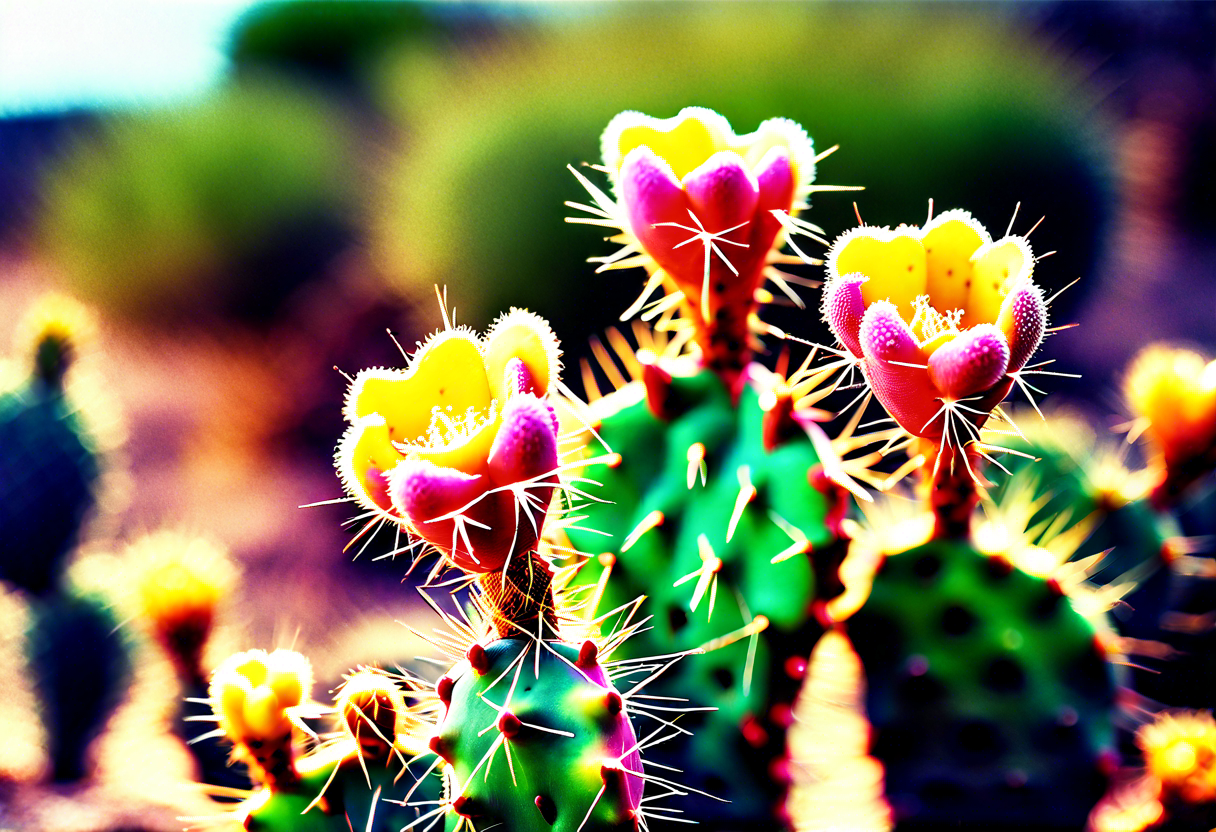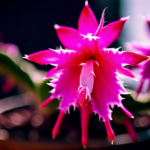Benefits and Uses of Prickly Pear Cactus (Opuntia)
Prickly Pear Cactus, scientifically known as Opuntia, is a versatile plant known for its various benefits and uses. Native to arid and semi-arid regions of the Americas, this succulent plant has been valued for centuries for its nutritional, medicinal, and culinary properties.
One of the key benefits of the Prickly Pear Cactus is its high antioxidant content. The cactus is rich in flavonoids, polyphenols, and betalains, which help combat oxidative stress in the body and reduce the risk of chronic diseases. Consuming Prickly Pear Cactus can aid in boosting the immune system and promoting overall well-being.
Additionally, the Prickly Pear Cactus is known for its anti-inflammatory properties. It has been used traditionally to alleviate various inflammatory conditions such as arthritis and skin irritations. The plant’s mucilage content has a soothing effect on the skin when applied topically, making it a popular natural remedy for sunburns and minor wounds.
Furthermore, Prickly Pear Cactus is prized for its culinary uses. The pads, known as nopales, and the sweet fruits, called tunas, are edible and commonly used in various dishes. Nopales are often sautéed with onions and spices or added to salads for a nutritional boost. The sweet and tangy tunas can be eaten fresh, turned into juice, or used in jams and desserts.
In traditional medicine, Prickly Pear Cactus has been utilized for its diuretic properties. It is believed to help regulate blood sugar levels and support kidney health. The plant’s high fiber content also contributes to improved digestion and may aid in weight management.
The Prickly Pear Cactus (Opuntia) is a remarkable plant with a wide range of benefits and uses. Whether consumed for its antioxidant properties, applied for its anti-inflammatory effects, or incorporated into culinary creations, this resilient cactus continues to captivate people worldwide. Embrace the versatility of the Prickly Pear Cactus and explore the numerous ways it can enhance your health and well-being.
For more information on Prickly Pear Cactus benefits and uses, visit Healthline.
How to Grow and Care for Prickly Pear Cactus Plants
Prickly pear cactus (Opuntia) is a low-maintenance plant that can thrive in various climates, making it a popular choice for both indoor and outdoor gardens. If you’re looking to add this unique and striking plant to your collection, here are some essential tips on how to grow and care for prickly pear cactus plants:
1. Planting:
When planting prickly pear cactus, ensure you choose a well-draining soil mix to prevent waterlogging, as this can cause root rot. If planting in a pot, make sure it has drainage holes at the bottom. For outdoor planting, select a sunny spot with good air circulation.
2. Watering:
Prickly pear cactus is drought-tolerant and does not require frequent watering. Allow the soil to dry out completely between waterings, especially during the winter months when the plant is dormant. Overwatering can lead to issues like yellowing pads and root rot.
3. Sunlight:
These cacti thrive in full sunlight. Make sure your prickly pear cactus receives at least 6-8 hours of direct sunlight each day to promote healthy growth and vibrant blooms. Insufficient sunlight can result in leggy growth and a lack of flowers.
4. Temperature:
Prickly pear cactus is well-suited to hot and dry climates. It can withstand high temperatures but may need protection from extreme heatwaves. During the winter, these plants can tolerate mild frosts but may require protection if temperatures drop significantly.
5. Fertilizing:
Fertilize your prickly pear cactus sparingly during the growing season with a balanced cactus fertilizer. Apply the fertilizer diluted to prevent root burn. Avoid fertilizing during the winter months when the plant is dormant.
6. Pruning:
Prickly pear cactus rarely requires pruning. Remove any dead or damaged pads using clean, sharp scissors or shears. Be cautious when handling the pads, as they are covered in glochids, tiny barbed bristles that can cause skin irritation.
By following these care tips, you can enjoy a thriving prickly pear cactus plant that adds beauty and character to your indoor or outdoor space. Remember to handle these plants with care due to their spines and glochids. prickly pear cactus into your garden can provide a unique and eye-catching addition that requires minimal maintenance.
For more in-depth insights and expert advice on cultivating prickly pear cactus plants, you can visit Cactus Recipes.
Benefits and Uses of Prickly Pear Cactus (Opuntia)
Prickly pear cactus, also known as Opuntia, is a versatile plant that offers numerous benefits and uses, especially in culinary applications. This resilient plant is not only drought-tolerant but also packs a nutritional punch, making it a valuable addition to various dishes. Let’s explore the culinary delights of cooking with prickly pear cactus.
Prickly pear cactus adds a unique flavor profile to dishes, often described as a blend of watermelon and pear with a hint of citrus. The pads, known as nopales, are commonly used in Mexican cuisine and can be prepared in a myriad of ways, including grilling, sautéing, or pickling. These versatile pads can be incorporated into salads, tacos, omelets, or even blended into smoothies for a nutritious boost.
One of the standout features of prickly pear cactus is its impressive nutritional content. Nopales are low in calories but rich in essential nutrients like fiber, vitamins (such as vitamin C and vitamin K), and minerals (including magnesium, calcium, and potassium). Additionally, they are loaded with antioxidants, which can help combat oxidative stress and inflammation in the body.
In traditional Mexican cuisine, prickly pear cactus is often used in dishes like nopales salad, where the pads are combined with tomatoes, onions, cilantro, and a squeeze of lime juice for a refreshing and vibrant side dish. Another popular dish is nopales con huevos, a flavorful combination of sautéed nopales with eggs, onions, and spices.
Apart from its culinary uses, prickly pear cactus has also been utilized in traditional medicine and remedies for centuries. The plant is believed to have various health benefits, including potential anti-inflammatory, antiviral, and antidiabetic properties. Studies have shown that prickly pear cactus extract may help lower blood sugar levels and reduce cholesterol levels, making it a promising natural remedy for managing diabetes and improving heart health.
Prickly pear cactus into your diet can not only introduce you to new and exciting flavors but also provide a range of health benefits. Whether you decide to cook with nopales or explore the medicinal properties of this versatile plant, prickly pear cactus is a true superfood that deserves a place in your kitchen and medicine cabinet.
To learn more about incorporating prickly pear cactus into your culinary repertoire, check out The Spruce Eats for delicious recipes and insightful tips on cooking with this nutritious ingredient.
Benefits of Prickly Pear Cactus (Opuntia) in Traditional Medicine and Remedies
Prickly Pear Cactus, also known as Opuntia, has been utilized for centuries in traditional medicine and home remedies due to its numerous health benefits. This resilient plant offers a wide array of medicinal properties that have been valued by various cultures around the world. Let’s delve into some of the traditional uses of Prickly Pear Cactus in promoting health and well-being.
Firstly, Prickly Pear Cactus is renowned for its ability to lower blood sugar levels, making it a valuable natural remedy for individuals with diabetes. Research has shown that consuming extracts from this cactus can help control blood glucose levels, making it a promising supplement for managing diabetes. Moreover, its high fiber content can aid in promoting digestive health and regulating bowel movements.
Furthermore, the Prickly Pear Cactus contains powerful antioxidants that help protect cells from damage caused by free radicals. These antioxidants play a crucial role in reducing inflammation, boosting the immune system, and preventing chronic diseases. Regular consumption of Prickly Pear Cactus can contribute to overall health and vitality.
In addition to its antioxidant properties, the Prickly Pear Cactus is rich in vitamins, minerals, and essential nutrients that support various bodily functions. It is a good source of vitamin C, vitamin E, magnesium, and potassium, all of which are vital for maintaining optimal health. Whether consumed raw, juiced, or in supplement form, incorporating Prickly Pear Cactus into your daily routine can provide a significant nutritional boost.
Moreover, Prickly Pear Cactus has been used topically to treat skin conditions such as burns, wounds, and insect bites. The gel-like substance found in the pads of the cactus can soothe skin irritations and promote healing. Its anti-inflammatory and antimicrobial properties make it a natural remedy for various skin ailments, offering a gentle and effective solution for skincare.
The Prickly Pear Cactus’s rich nutritional profile, antioxidant content, and medicinal properties make it a versatile plant with numerous health benefits. Whether used internally as a dietary supplement or externally for skin care, incorporating Prickly Pear Cactus into your health and wellness routine can have positive effects on your overall well-being.
For more information on the traditional uses and benefits of Prickly Pear Cactus in traditional medicine, visit <a href="https://www.herbal-supplement-resource.com/prickly-pear-cactus.html" target="_blank>Herbal Supplement Resource.
Ecological Importance of Prickly Pear Cactus in Arid Environments
The Prickly Pear Cactus, scientifically known as Opuntia, plays a crucial role in maintaining the delicate balance of arid environments around the world. These resilient plants have adapted to thrive in harsh conditions and provide various ecological benefits that support the biodiversity of arid regions.
One of the key roles of the Prickly Pear Cactus is its ability to prevent soil erosion in arid environments. The extensive root system of these cacti helps bind the soil together, reducing the risk of erosion caused by wind and water. This is particularly important in regions where vegetation is sparse, and the risk of desertification is high.
Furthermore, Prickly Pear Cacti serve as food and shelter for a variety of wildlife species. Birds, insects, and mammals rely on the cactus for nourishment, moisture, and protection from predators. By acting as a habitat for these animals, the Prickly Pear Cactus contributes to the overall biodiversity of arid ecosystems.
In addition to supporting wildlife, Prickly Pear Cacti also play a role in the nutrient cycle of arid environments. When these cacti shed their pads or fruits, the organic matter enriches the soil, providing essential nutrients for other plants in the ecosystem. This process helps sustain plant life in arid regions where resources are limited.
Moreover, the Prickly Pear Cactus is a drought-resistant plant that requires minimal water to survive. In water-stressed environments, this cactus serves as a model for water conservation and sustainable growth. Its ability to store water in its pads allows it to withstand long periods of drought, making it an essential component of arid ecosystems.
The ecological importance of the Prickly Pear Cactus in arid environments cannot be overstated. From preventing soil erosion to supporting wildlife and enriching the soil, these cacti are vital to the delicate balance of arid ecosystems. By conserving and protecting these plants, we can ensure the resilience and sustainability of arid environments for future generations.
For more information on the ecological importance of Prickly Pear Cactus, visit Desert Museum.
Conclusion
Prickly pear cactus (Opuntia) into various aspects of our lives can bring about a multitude of benefits and opportunities. The plant’s versatility makes it a valuable asset in both culinary and medicinal realms. With its high nutritional value and unique flavor profile, prickly pear cactus has found its way into kitchens worldwide, adding a touch of exoticism to dishes and beverages. From savory stews to refreshing cocktails, the incorporation of this cactus species introduces a new dimension to gastronomic exploration.
Moreover, the traditional medicinal applications of prickly pear cactus underscore its significance beyond the realm of food. For centuries, various cultures have recognized the plant’s therapeutic properties, utilizing it to address an array of health concerns. From skincare remedies to blood sugar regulation, prickly pear cactus demonstrates a wide range of potential health benefits. Its antioxidant-rich composition and anti-inflammatory qualities contribute to its effectiveness in promoting overall well-being and vitality.
In addition to its culinary and medicinal value, the ecological role of prickly pear cactus cannot be overlooked. In arid environments where water is scarce and temperatures are extreme, this resilient plant species thrives, offering crucial support to local ecosystems. As a source of food and shelter for wildlife, prickly pear cactus plays a vital role in maintaining biodiversity and ecological balance in desert regions. By conserving and promoting the growth of these plants, we can contribute to the preservation of fragile ecosystems and the species that depend on them for survival.
Growing and caring for prickly pear cactus plants can be a rewarding experience for enthusiasts and gardeners alike. With proper guidance on cultivation and maintenance practices, individuals can cultivate thriving cactus gardens that not only enhance their surroundings aesthetically but also serve as a sustainable source of edible and medicinal resources. By understanding the unique needs of prickly pear cactus and providing the necessary care, individuals can enjoy the beauty and utility of these remarkable plants in their own homes and gardens.
The prickly pear cactus (Opuntia) stands as a symbol of resilience, adaptability, and resourcefulness. Its benefits and uses extend far beyond ornamental purposes, enriching our lives through culinary exploration, holistic health practices, and environmental conservation efforts. By embracing the multifaceted nature of this remarkable plant species, we unlock a world of possibilities that connect us more deeply with nature and its abundance. Let us continue to appreciate and cultivate prickly pear cactus, honoring its contributions to our well-being, culture, and the planet we all call home.


